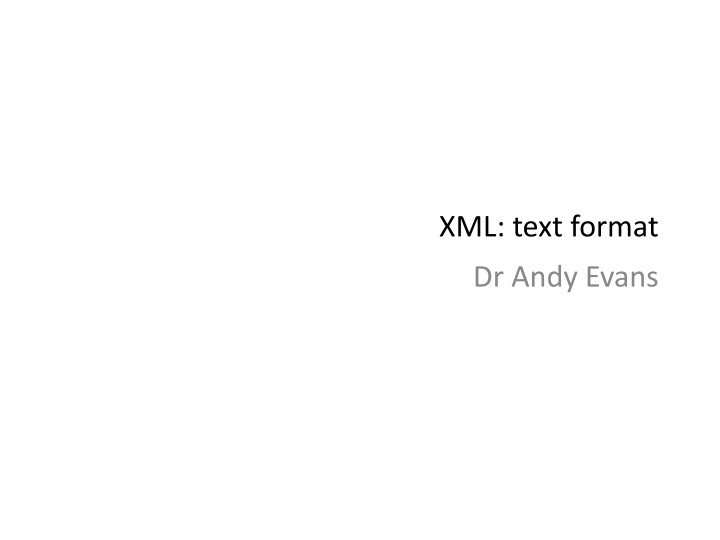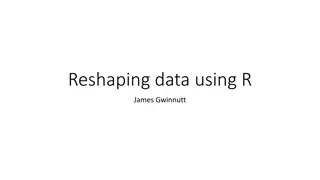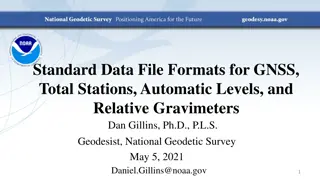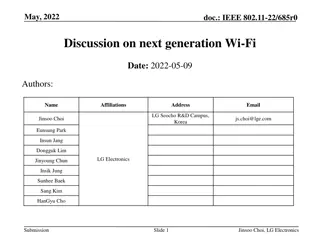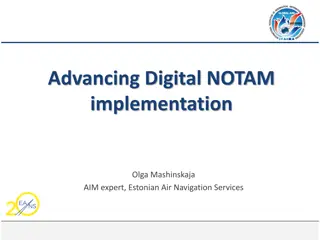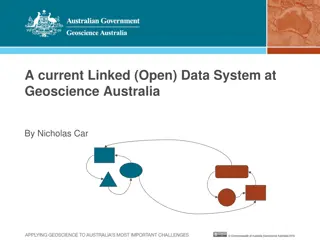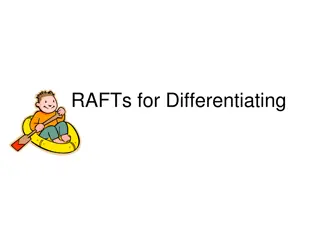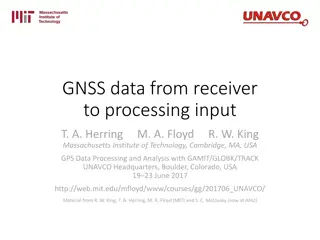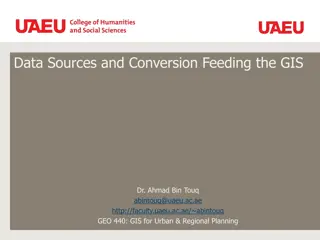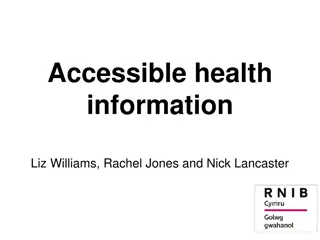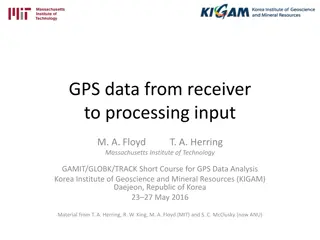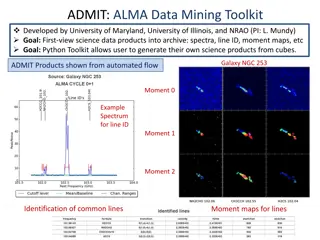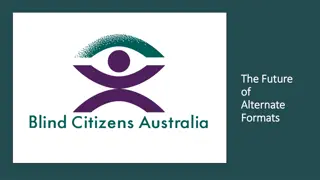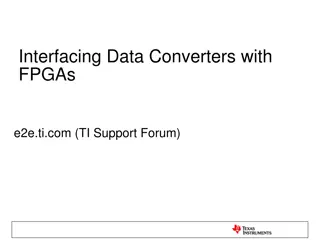Evolution of Data Formats in Information Technology
Over time, as data space became more affordable, there has been a shift towards text-based data formats in information technology. This evolution has led to a transition from binary formats to text, making data more understandable for both humans and coders. The move to open data formats, based on international standards, has facilitated easier data transfer between software systems. Various formats such as XML, CSV, JSON, markup languages like HTML, and GML have played crucial roles in shaping the modern data landscape.
Download Presentation

Please find below an Image/Link to download the presentation.
The content on the website is provided AS IS for your information and personal use only. It may not be sold, licensed, or shared on other websites without obtaining consent from the author.If you encounter any issues during the download, it is possible that the publisher has removed the file from their server.
You are allowed to download the files provided on this website for personal or commercial use, subject to the condition that they are used lawfully. All files are the property of their respective owners.
The content on the website is provided AS IS for your information and personal use only. It may not be sold, licensed, or shared on other websites without obtaining consent from the author.
E N D
Presentation Transcript
XML: text format Dr Andy Evans
Text-based data formats As data space has become cheaper, people have moved away from binary data formats. Text easier to understand for humans / coders. Move to open data formats encourages text. Text based on international standards so easier to transfer between software.
CSV Classic format Comma Separated Variables (CSV). 10,10,50,50,10 10,50,50,10,10 25,25,75,75,25 25,75,75,25,25 50,50,100,100,50 50,100,100,50,50 Easily parsed (see Core course). No information added by structure, so an ontology (in this case meaning a structured knowledge framework) must be externally imposed.
JSON (JavaScript Object Notation) { "type": "FeatureCollection", "features": [ { "type": "Feature", "geometry": { "type": "Point", "coordinates": [42.0, 21.0] }, "properties": { "prop0": "value0" } }] } Increasing popular light- weight data format. Text attribute and value pairs. Values can include more complex objects made up of further attribute-value pairs. Easily parsed. Small(ish) files. Limited structuring opportunities. GeoJSON example
Markup languages Tags and content. Tags often note the ontological context of the data, making the value have meaning: that is determining its semantic content. All based on Standard Generalized Markup Language (SGML) [ISO 8879]
HTML Hypertext Markup Language Nested tags giving information about the content. <HTML> <BODY> <P><B>This</B> is<BR>text </BODY> </HTML> Note that tags can be on their own, some by default, some through sloppiness. Not case sensitive. Contains style information (though use discouraged).
XML eXtensible Markup Language More generic. Extensible not fixed terms, but terms you can add to. Vast number of different versions for different kinds of information. Used a lot now because of the advantages of using human- readable data formats. Data transfer fast, memory cheap, and it is therefore now feasible.
GML Major geographical type is GML (Geographical Markup Language). Given a significant boost by the shift of Ordnance Survey from their own binary data format to this. Controlled by the Open GIS Consortium: http://www.opengeospatial.org/standards/gml <gml:Point gml:id="p21 srsName="http://www.opengis.net/def/crs/EPSG/0/4326"> <gml:coordinates>45.67, 88.56</gml:coordinates> </gml:Point>
Simple example (Slightly simpler than GML) <?xml version="1.0" encoding="UTF-8"?> <map> <polygon id="p1"> <points>100,100 200,100 200, 200 100,000 100,100</points> </polygon> </map>
Text As some symbols are used, need to use & < > " for ampersand, <, >, " <! Comment --> CDATA blocks can be used to literally present text that otherwise might seem to be markup: <![CDATA[text including > this]]>
Simple example Prolog: XML declaration (version) and text character set <?xml version="1.0" encoding="UTF-8"?> <map> <polygon id="p1"> <points>100,100 200,100 200, 200 100,000 100,100</points> </polygon> </map> Tag name-value attributes
Well Formedness XML checked for well-formedness. Most tags have to be closed you can t be as sloppy as with HTML. Empty tags not enclosing look like this: <TAG /> or <TAG/>. Case-sensitive.
Document Object Model (DOM) One advantage of forcing good structure is we can treat the XML as a tree of data. Each element is a child of some parent. Document has a root. 100,100 Polygon 200,100 id= p1 200,200 Map 0, 10 Polygon 10,10 id = p2 10,0
Schema As well as checking for well-formedness we can check whether a document is valid against a schema : definition of the specific XML type. There are two popular schema types in XML: (older) DTD (Document Type Definition) (newer) XSD (XML Schema Definition) XSD more complex, but in XML itself only need one parser. In a separate text file, linked by a URI (URL or relative file location).
DTD DTD for the example: <!ELEMENT map (polygon)*> <!ELEMENT polygon (points)> <!ATTLIST polygon id ID #IMPLIED> <!ELEMENT points (#PCDATA)> "map"s may contain zero or more "polygon"s; "polygon"s must have one set of "points", and can also have an "attribute" "id". Points must be in text form. For dealing with whitespace, see XML Specification.
Linking to DTD Root element <?xml version="1.0" encoding="UTF-8"?> <!DOCTYPE map SYSTEM "map1.dtd"> <map> <polygon id="p1"> <points>100,100 200,100 200, 200 100,000 100,100</points> </polygon> </map> Put XML and DTD files in a directory and open the XML in a web browser, and the browser will check the XML.
XSD <xsi:schema xmlns:xsi="http://www.w3.org/2001/XMLSchema" targetNamespace="http://www.geog.leeds.ac.uk" xmlns="http://www.geog.leeds.ac.uk" elementFormDefault="qualified"> <xsi:element name="map"> <xsi:complexType> <xsi:sequence> <xsi:element name="polygon" minOccurs="0" maxOccurs="unbounded"> <xsi:complexType> <xsi:sequence> <xsi:element name="points" type="xsi:string"/> </xsi:sequence> <xsi:attribute name="id" type="xsi:ID"/> </xsi:complexType> </xsi:element> </xsi:sequence> </xsi:complexType> </xsi:element> </xsi:schema>
XSD Includes information on the namespace: a unique identifier (like http://www.geog.leeds.ac.uk). Allows us to distinguish our XML tag "polygon" from any other "polygon" XML tag.
Linking to XSD <?xml version="1.0" encoding="UTF-8"?> <map xmlns:xsi="http://www.w3.org/2001/XMLSchema-instance" xsi:schemaLocation="http://www.geog.leeds.ac.uk > <polygon id="p1"> <points>100,100 200,100 200, 200 100,000 100,100</points> </polygon> </map> map2.xsd" Note server URL and relative file location could just be a URL.
